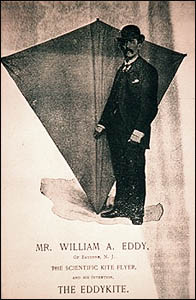Layang-layang Melayu
 | |||
| |||
| |||
| |||

Layang-layang Melayu ialah sejenis layang-layang tanpa ekor. Pertama kali diperkenalkan ke Barat dalam sebuah rencana surat khabar New York dari Oktober 1894, layang-layang Melayu digunakan untuk rekreasi selama berabad-abad sebelum ini di beberapa tempat di Timur Jauh. Rencana itu memperincikan bagaimana seorang profesor universiti ("Clayton") telah mendirikan satu siri layang-layang dan membalut mereka sekaligus pada satu layang-layang. Layang-layang ini tiada ekor, melengkung dan berbentuk wajik, dan dirujuk oleh pengarang rencana sebagai "layang-layang Melayu". Meskipun begitu, kemunculan reka bentuk ala Melayu ini mungkin pernah didengari di Amerika Syarikat sebelum penerbitan rencana tersebut; dalam edisi terakhir American Boy's Handy Book, suatu lagi layang-layang tanpa ekor diperincikan (dan dirujuk sebagai layang-layang "Holland"). Penjelasan layang-layang ini, yang telah dimasukkan sebagai satu bab dalam buku, telah dikirimkan kepada pengarang sekitar 1882, sebelas tahun sebelum layang-layang Melayu disebutkan dalam surat khabar tadi.[1]
Reka bentuk
[sunting | sunting sumber]The Malay is similar in design to the standard Eddy design.[2] The precise design of the kite consists of two flexible cross sticks, diverging at right angles, to form a lozenge-like shape. The horizontal stick is preferably slightly longer than the vertical one. Once they have been bound together, a string or cord is tightened around the resulting lozenge. The design is then enveloped in the kite material, such as paper. This particular design, when correctly executed, allows the wind to carry the kite to great heights, despite its lack of any kind of tail.[3]
This diamond-bowed design gave inspiration to other designs, such as the aforementioned and now popular "Eddy" kite, designed by William Abner Eddy of Bayonne, New Jersey. The "Eddy" model, created four years after the Western appearance of the Malay in 1894, and patented approximately twenty months after that — application for "Kite" filed on 1 August 1898, by "William A. Eddy of Bayonne, New Jersey", U.S. patent number 646375 (issued on 27 March 1900) — has grown to become one of the most common and popular designs of kite in the 21st century.[2]
The Malay kite design is also known to be capable of holding a man aloft for a substantial period of time. W. A. Eddy himself demonstrated this when he remained suspended in the air for approximately 15 hours. Using nine Malay kites tied together by a two mile long cord, Eddy reached—at his highest point—somewhere around 5,595 feet (1,705 m) in altitude.[4]
Lihat juga
[sunting | sunting sumber]- Wau bulan, sejenis layang-layang yang juga dikaitkan dengan etnik Melayu dan sama sekali berbeza.
Catatan
[sunting | sunting sumber]Rujukan
[sunting | sunting sumber]- Beard, Daniel Carter (2000). The Outdoor Handy Book: For Playground Field and Forest. The Minerva Group, Inc. ISBN 0898751357.
- Chanute, Octave (1997). Progress in Flying Machines. Courier Dover Publications. ISBN 0486299813.
- Eden, Maxwell (2002). The Magnificent Book of Kites. Sterling Publishing Company, Inc. ISBN 1402700946.


